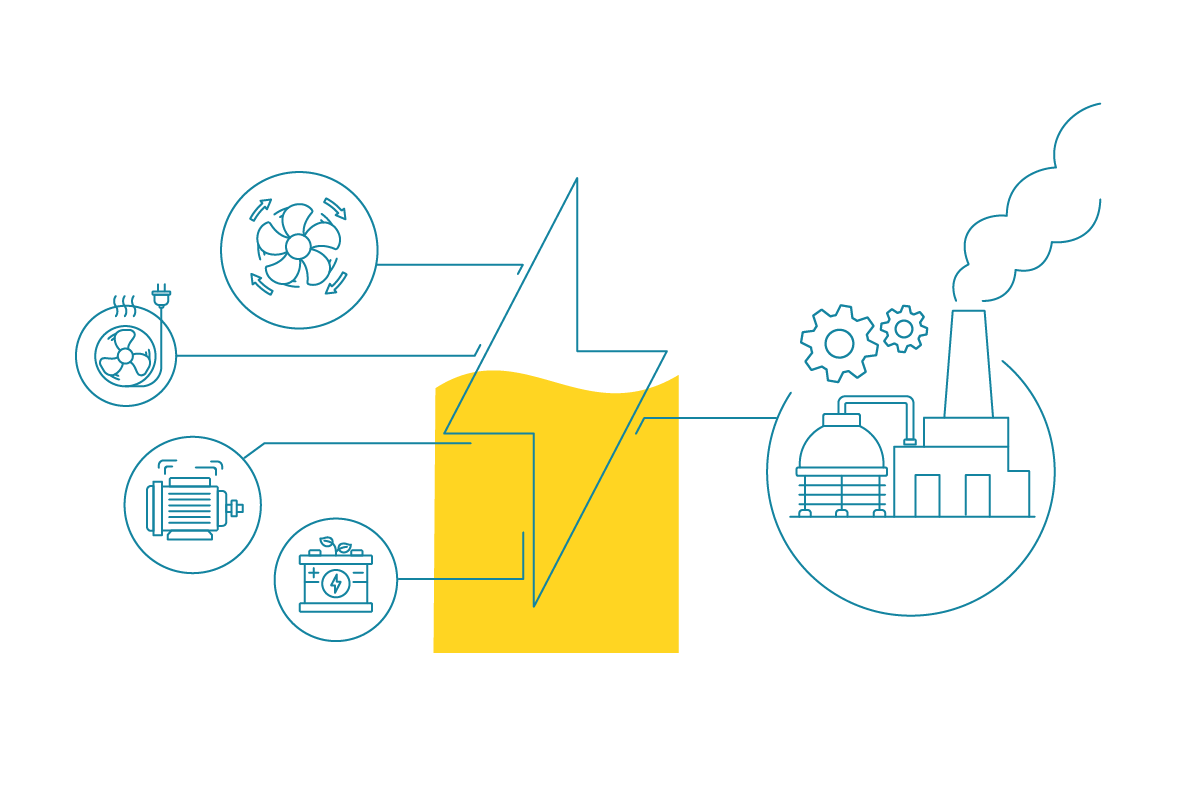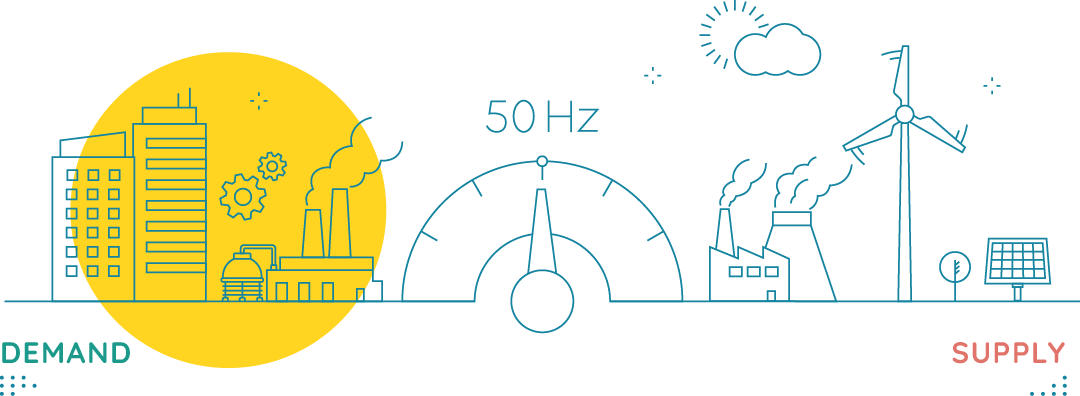Smart Grid Explained
.jpg?width=768&name=Article%20Thumbnails%20-%201920x1080%20new%20website%20(25).jpg)
Decarbonising our energy system is crucial to overcome the climate crisis. That means getting the most out of renewable energy sources like wind and solar. Unfortunately, those sources are weather-dependent and often output energy intermittently. Smart grids are the solution to this problem. They have a huge potential to make our electricity systems more resilient and accelerate the energy transition.
Jump to:
- What is a Smart Grid?
- Smart Grid vs. Traditional Electricity Grids
- Smart Grid Technology
- Why do we need Smart Grids?
- The Role of Demand Response in Smart Grids
- Power Systems of the Future

What is a Smart Grid?
Smart grids are electricity networks that use emerging technologies to sense and respond to change. This means they can continually adjust supply to match demand and keep themselves operational while supplying everything with power.
But how do smart grids achieve this? Smart grids can be so responsive thanks to a two-way flow of electricity and data. A two-way flow allows them to swiftly detect and react to changes in energy usage. Not only does this allow smart grids to be proactive in the face of unexpected issues, but it also gives them more resilience compared to traditional electricity grids.
Smart Grid vs. Traditional Electricity Grids
All electricity grids are networks that deliver electricity from power generation sources (power plants) to end-users (businesses, factories, homes). Once upon a time, factories and businesses had to be close to the electricity sources that they were using. It wasn’t until power grid systems were created that electricity could be shared across vast distances.
Electricity grids achieve this through a network of transmission lines. Energy moves along these lines at a high voltage to minimise energy waste. From here, another network known as a distribution network carries the electricity to end-users. What connects these two networks together is known as a substation. Substations have the essential job of adjusting the high voltage of transmission lines, to the lower voltage needed for distribution and use.
A smart grid does everything a traditional energy grid does, however it also acts as a communication channel between electricity suppliers and users. It does this through sensing and monitoring technology, as well as transferring data throughout the grid. It creates a more versatile and reliable grid using a number of different smart technologies.
Smart Grid Technology
Smart grid technology is continually evolving, but it all revolves around data: monitoring, measuring, sharing and acting on information.
- Smart meters
Smart meters monitor usage close to real-time (usually half-hourly chunks) and share this information with both the customer and the supplier.
- Phasor measurement units (PMUs)
PMUs monitor fluctuations in voltage or current to ensure that the power going into the grid won’t damage electrical appliances. PMUs take 30-60 measurements per second, which is a huge improvement on older monitoring technology.
- Digital protective relays
These relays take action to protect the network if something goes wrong. Excess current can damage equipment and is a fire risk, but protective relays can respond within seconds to sound an alarm or trigger a circuit breaker. Unlike the older type of electromechanical relay, digital relays have both hardware and software.
Automated feeder switches
These switches transfer current from an overloaded line to its more lightly loaded neighbour, balancing out the power load.
Why do we need Smart Grids?
Smart grids transport information as well as electricity, which gives us the data necessary to manage our energy systems. Grid operators have the difficult job of using that data to ensure that the overall electricity supply matches demand at all times. That requires constant communication with highly dynamic energy markets while asking generators to turn their power up or down to match demand.
In the past, forecasting was the most important tool for balancing supply with demand. It’s not a myth that there is a surge in demand when popular television programmes are broadcast – one episode of Coronation Street caused a surge of 800 megawatts after hundreds of thousands of viewers put the kettle on at once!
But forecasting is no longer practical for every situation, as it can’t predict smaller hourly and half-hourly changes in energy demand. To do that, operators need real-time information. That’s why smart grids are necessary. They make it possible to instantly adjust supply to meet real-time demand through smart meters and a constant stream of data.
The Role of Demand Response and Battery Storage in Supporting Smart Grids

In the past, grid operators would maintain balance by managing supply in order to meet demand. But within smart grids, demand isn’t just something to match. It can be something to manage too. Modern grids should meet demand in a smarter way, utilising all types of flexibility solutions, such as demand response and BESS. Demand Response is a method in which the energy consumed by customers is changed in order to help balance grid frequency. Like any virtual power plant (VPP), it is a decentralised web of energy assets that act as energy sources for smart grids to tap into. However, rather than being on the supply side, it operates on the demand side. Battery Energy Storage Systems (BESS) support shifting energy consumption when demand is high and generation low, by storing excess energy when production is high for later use.
These advanced forms of energy supply are only possible through the technology supplied by smart grids. Without them, we wouldn’t have the flexible and reliable energy grids emerging today. It’s because of them that consumers can make more informed choices about their power use.
Power Systems of the Future
Over 130 countries have either set or are considering a net-zero emissions target by 2050. This requires us to act quickly to decarbonise our energy supply. But renewable energy systems are limited by their intermittent nature. How do you keep the lights on when the sun isn’t shining and the wind isn’t blowing?
Smart grids can optimise the link between customer demand and the supply of renewable energy. They can also utilise the potential of energy storage by ensuring power is stored when it’s abundant and cheap, then release it during demand spikes. While this power system is far off, smart grid technology will help us get there by providing key insight into energy markets.
The switch from traditional electricity grids to smart grids will be gradual. But over 50 countries around the world are investing in smart grids, with each working towards a unique definition of success. What they all share is a recognition of what this technology can achieve: greater energy efficiency, lower carbon emissions and a more reliable electricity grid.
Unlock New Revenue Streams with Demand Response
Check out our essential guide to energy flexibility.
Other articles you might find interesting
-
 Smart grid2 May 2022
Smart grid2 May 2022The Problem with Renewables, and How to Fix It
Read more -
.jpg?length=500&name=Article%20Thumbnails%20-%201920x1080%20new%20website%20(18).jpg) Smart grid2 May 2022
Smart grid2 May 2022Power Grids & Outages - All You Need to Know
Read more -
.jpg?length=500&name=Article%20Thumbnails%20-%201920x1080%20new%20website%20(20).jpg) Smart grid2 May 2022
Smart grid2 May 2022Energy and Electricity - What’s the Difference?
Read more -
.jpg?length=500&name=Article%20Thumbnails%20-%201920x1080%20new%20website%20(2).jpg) Smart grid2 May 2022
Smart grid2 May 2022What is a Virtual Power Plant? VPP Explained
Read more -
.jpg?length=500&name=Article%20Thumbnails%20-%201920x1080%20new%20website%20(22).jpg) Smart grid2 May 2022
Smart grid2 May 2022What is Electrification? Definition and Examples
Read more